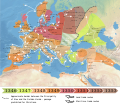 | of Yersinia are pathogenic in humans; in particular, Y. pestis is the causative agent of the plague. Rodents are the natural reservoirs of Yersinia; less... 10 KB (889 words) - 23:14, 17 April 2024 |
 | 14th century population. Bubonic plague is caused by the bacterium Yersinia pestis and spread by fleas. One of the most significant events in European... 127 KB (13,681 words) - 16:20, 19 April 2024 |
 | of Justinian was Yersinia pestis, the same bacterium responsible for the Black Death (1346–1353). Ancient and modern Yersinia pestis strains are closely... 29 KB (3,202 words) - 16:01, 15 March 2024 |
Studies in Sweden, on the Gok2 Neolithic Yersinia pestis strain, was discovered to be the basal to all known Y. pestis strains with the use of genome reconstruction... 11 KB (1,296 words) - 16:58, 19 January 2024 |
transmission of Yersinia pestis is generally thought to occur only through the bites of fleas whose mid guts become obstructed by replicating Y. pestis several... 33 KB (4,340 words) - 01:38, 15 February 2024 |
Look up pestis or nosos in Wiktionary, the free dictionary. Pestis may refer to: Plague (disease) Yersinia pestis, a Gram-negative rod-shaped bacterium... 886 bytes (139 words) - 07:56, 19 May 2020 |
 | Plague is an infectious disease caused by the bacterium Yersinia pestis. Symptoms include fever, weakness and headache. Usually this begins one to seven... 33 KB (3,616 words) - 00:39, 26 April 2024 |
 | Chinatown, Honolulu (section Yersinia pestis in Hawaii) total of 71 cases and 61 fatalities were reported by Board of Health. Yersinia pestis, the bacterium that causes bubonic plague, is transmitted by the oriental... 27 KB (2,891 words) - 14:41, 13 February 2024 |
 | Yersiniabactin (section Role in Yersinia pathogenicity) siderophore found in the pathogenic bacteria Yersinia pestis, Yersinia pseudotuberculosis, and Yersinia enterocolitica, as well as several strains of... 10 KB (1,030 words) - 15:22, 5 March 2024 |
 | Plague vaccine is a vaccine used against Yersinia pestis to prevent the plague. Inactivated bacterial vaccines have been used since 1890 but are less... 5 KB (465 words) - 13:42, 8 March 2024 |
 | shrews. The oriental rat flea, Xenopsylla cheopis, is a vector of Yersinia pestis, the bacterium that causes bubonic plague. The disease was spread to... 43 KB (4,667 words) - 14:46, 15 April 2024 |
 | Pneumonic plague is a severe lung infection caused by the bacterium Yersinia pestis. Symptoms include fever, headache, shortness of breath, chest pain... 24 KB (2,416 words) - 16:57, 30 January 2024 |
 | Gram-negative coccobacillus responsible for causing whooping cough. Yersinia pestis, the bacterium that causes plague, is also coccobacillus. Coxiella... 3 KB (232 words) - 03:56, 15 December 2023 |
following an accidental laboratory exposure to an attenuated strain of Yersinia pestis, a bacterium that causes plague. Casadaban was born to John and Dolores... 5 KB (429 words) - 05:47, 12 July 2023 |
 | of London's population—in 18 months. The plague was caused by the Yersinia pestis bacterium, which is usually transmitted to a human by the bite of a... 46 KB (6,355 words) - 12:05, 11 March 2024 |
 | Asia around the mid-19th century. Plague is caused by the bacterium Yersinia pestis, which exists in parasitic fleas of several species in the wild and... 56 KB (6,272 words) - 17:31, 7 April 2024 |
(typeface class), a typeface family designed between about 1470 and 1600 a Yersinia pestis biovar thought to correspond to the Plague of Justinian A common misspelling... 438 bytes (89 words) - 01:43, 2 April 2022 |
longevity. Yersinia pestis is a gram-negative bacterium and belongs to the family of Enterobatteriaceae. Its closest relatives are Yersinia pseudotuberculosis... 43 KB (5,940 words) - 18:21, 1 December 2023 |
that contain a sylvatic cycle include trichinosis, dengue viruses, Yersinia pestis, Chagas disease, and rabies. Sylvatic plague Fernandes O, Mangia RH... 3 KB (282 words) - 12:12, 30 May 2023 |
 | Escherichia coli, Salmonella, Listeria spp., Shewanella oneidensis and Yersinia pestis. Certain eukaryotes are also facultative anaerobes, including fungi... 11 KB (999 words) - 20:35, 29 March 2024 |
 | is an infectious bacterial disease caused by the plague bacterium (Yersinia pestis) that primarily affects rodents, such as prairie dogs. It is the same... 5 KB (546 words) - 18:05, 2 April 2024 |







